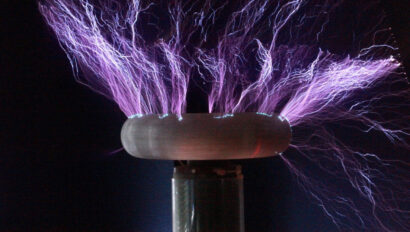
Electricity is one of the most useful discoveries of our relatively recent history. It lights the rooms we hang out in, give power to some vehicles and allows for communication across vast distances. In 1800, Italian physicist Alessandro Volta discovered that particular chemical reactions could produce electricity so he constructed the voltaic pile (an early electric battery) that produced a steady electric current. Since then, electricity has been adapted to try to fit the needs of people better. Let’s explore 2 different ways we can see the effects of electricity.
Static Electricity
Have you experienced rubbing your feet on carpet just to reach out to someone and give them a little zap? Or slide down a plastic slide and gotten a nice jolt from it? What about rubbing a balloon on your head to make your hair stand on end? A Van De Graaf generator is a tool to experience even more static electricity!  Static electricity is an imbalance of electric charge on a surface. The charge remains imbalanced until there is an electric current or an electrical discharge. A Van De Graaf generator works much the same as rubbing your feet on the carpet to move electrons throughout your body. A moving belt in the generator accumulates an excess of electric charge which is then transferred to a large hollow sphere.
Static electricity is an imbalance of electric charge on a surface. The charge remains imbalanced until there is an electric current or an electrical discharge. A Van De Graaf generator works much the same as rubbing your feet on the carpet to move electrons throughout your body. A moving belt in the generator accumulates an excess of electric charge which is then transferred to a large hollow sphere. The sphere builds up free electrons which all have a negative charge. When too many negative charges are near one another they will start to repel. If you force enough of them onto a single surface you can build up enough charge to see an effect such as your hair standing on end, pie tins flying off due to repulsion, or a shock!
The sphere builds up free electrons which all have a negative charge. When too many negative charges are near one another they will start to repel. If you force enough of them onto a single surface you can build up enough charge to see an effect such as your hair standing on end, pie tins flying off due to repulsion, or a shock! Electricity will take the path of least resistance and wants to be neutral. As shown here, a fun and safe way to manipulate the static electricity is with a grounding rod. The grounding rod neutralizes the Van De Graaf generator by moving all of the excess charge from it to the surface of the Earth.
Electricity will take the path of least resistance and wants to be neutral. As shown here, a fun and safe way to manipulate the static electricity is with a grounding rod. The grounding rod neutralizes the Van De Graaf generator by moving all of the excess charge from it to the surface of the Earth. You can also neutralize the generator without a grounding rod. Humans are decent conductors of electricity. This means that your body could act as a grounding rod too. Just remember that you have one thing that a grounding rod does not…NERVES. If you decide to ground the sphere, brace yourself for quite the jolt!
You can also neutralize the generator without a grounding rod. Humans are decent conductors of electricity. This means that your body could act as a grounding rod too. Just remember that you have one thing that a grounding rod does not…NERVES. If you decide to ground the sphere, brace yourself for quite the jolt!
The Tesla Coil
In 1891, inventor Nikola Tesla wanted to make a way to transmit electricity without the use of wires, so that more people could have access to a city’s source. He created the Tesla coil, a resonant transformer circuit to try to do just that.

However, with this new technology came challenges. It turns out that spraying electricity into the air is a waste. Whether the power would be used or not, it’ll eventually dissipate. It is also quite dangerous without the use of proper equipment. The large arcs of electricity that you see are about 650,000 volts! For comparison, the electricity that comes out of your wall is at about 120 volts, which is dangerous in its own right.
Today, Tesla coils are not used for free energy, or really anything useful. However, they are used far and wide in classrooms as scientific demonstrations! They are also, really fun to play with, as long as you do so safely. Faraday cages or grounding rods should always be used, and can even be used to control the flow of the electric discharge!

